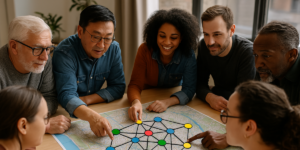Who is the Best Person to Take My Network Survey?

If you’ve ever designed a survey, you know that one of the most crucial steps is picking respondents. For a survey of members of an inter-organizational network, this step usually first involves identifying the organizations to which to distribute the survey. At Visible Network Labs, we refer to this process as “bounding your network” or “building your bounded list.” Click here to read our Brief on the subject.
Once you’ve decided on a list of organizations in your network to survey, the next step is identifying the best person in each of those organizations to answer the survey questions on behalf of the whole organization. Sometimes this task is easy. If your network is an already-established group with a formalized list of individuals who consistently represent member organizations at group meetings, you may simply need to consult this list and confirm that it’s up-to-date.

Sometimes, however, this task is more complicated. Maybe you’re with the backbone organization for a nascent network and you haven’t identified a point person in each organization. Perhaps you’re part of an informal network of groups that share common goals but that operate very loosely. Or maybe, you are part of a network in which there is no consistent organizational representative. Multiple different representatives from each organization participate, depending on the activity or goal. In these cases, deciding on the best respondents to answer survey questions on behalf of their organizations becomes a more difficult task.
As we all know from working in organizations, everyone on a team has their own understanding of the inter-organizational relationships external to the organization. It’s similar to how each person holds a slightly different mental model of the interpersonal relationships within the organization. As a result, any two employees may have slightly different understandings of their organization’s network relationships, depending on their job responsibilities, level of institutional memory, etc. So which organizational representative is the best respondent for your network survey?
- Think about specific survey questions you wish to ask, and who in the organization is best suited to answer them.
- Allow for the possibility that multiple people from one organization may need to answer the survey together. Leave time for this possibility in case it’s delaying your results. Also, include instructions at the beginning of the survey explaining that collaborating on survey results is allowed. It may even be desirable. In addition, make sure that if you are using an online survey format, the survey link can be shared, and the survey can be stopped and started over multiple response sessions.
- However, do send your survey to one designated contact person. Sending the survey to an “info@” email address means that no one person may feel responsible for completing the survey. Without a designated contact person, you also cannot personalize survey invitations and reminders, a step that we know increases response rates.
- Consider job title when selecting organizational respondents. Many assume that senior employees are more likely to have responsibility and knowledge of an organization’s external partnerships. There’s significant research to back up this assumption.
- But also, consider a potential respondent’s organizational tenure, if you have access to that information. In a study, Tom Valente and I conducted on a set of nonprofit health care coalitions, we found evidence to suggest that potential respondents with longer tenures in their organizations or in their industry overall were more reliable informants than those with more senior job titles





